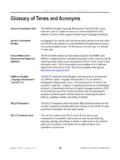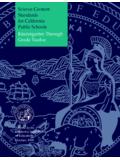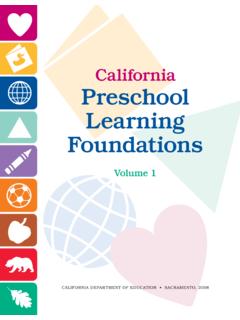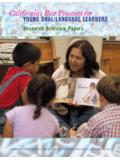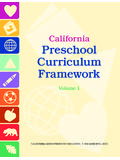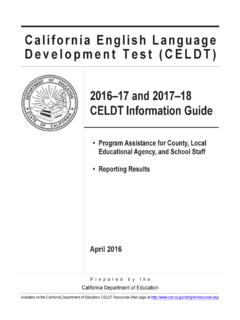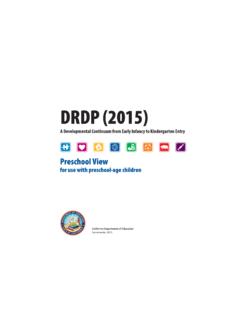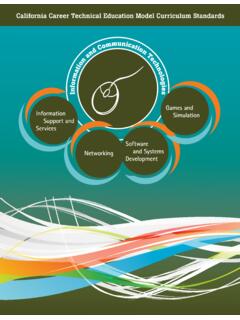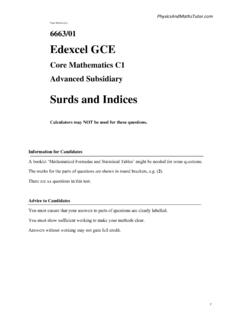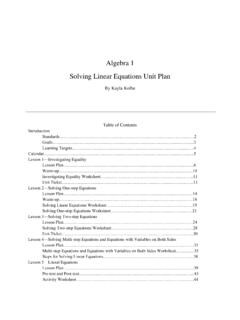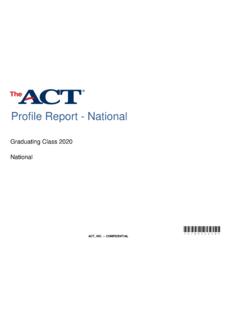Transcription of Technology in the Teaching of Mathematics Chapter
1 Technology in the Teaching of Mathematics Chapter of the Mathematics Framework for California Public Schools: Kindergarten Through Grade Twelve Adopted by the California State Board of Education, November 2013. Published by the California Department of Education Sacramento, 2015. Technology in the Teaching of Mathematics T. he field of Mathematics education has changed greatly because of Technology . Educational Technology can facilitate simple computation and the visualization of Mathematics situations and relationships, allowing students to better comprehend mathematical concepts in practice. Technology can be a tool for students to model mathematical relationships in real-world situations.
2 Technology is also an integral part of the common core State Standards Initiative and its emphasis on preparing students for college and twenty-first-century careers. Technology pervades modern society. In such an environment, the question is not whether educational Technology will be used in the classroom, but how best to use it (Cheung and Slavin 2011). Current- generation students are digital natives, and the generation of teachers who will enter the profession over the next few decades will likewise be the product of a culture in which Technology is a constant presence and where the use of Technology in education is a fundamental assumption.
3 Training and supporting teachers in the use of Technology are essential to the effective use of Technology in the classroom. Educational Technology is a broad category that includes both a wide range of electronic devices and the applications that deliver content and support learning. Technology is an essential tool for learning Mathematics in the twenty-first century, but it is only a tool; it cannot replace conceptual understand- ing, computational fluency, or problem-solving skills. Technological tools include both content-specific technologies ( , computer programs and computational devices) and content-neutral technologies, such as communication and collaboration tools (National Council of Teachers of Mathematics [NCTM].)
4 2011a). According to guidelines adopted by the state of Massachusetts to help construct and evaluate curriculum, Technology changes the Mathematics to be learned, as well as when and how it is learned .. Some Mathematics becomes more important because Technology requires it, some be- comes less important because Technology replaces it, and some becomes possible because Technology allows it (Massachusetts Department of Elementary and Secondary Education 2011).1. Research completed over the past decade has confirmed the potential benefits of educational Technology applied to the Teaching and learning of Mathematics . When used effectively, educational Technology can enhance student understanding of mathematical concepts, bolster student engagement, and strengthen problem-solving skills.
5 Most of the recent meta-analyses of research studies in this area, however, note that these benefits depend on how educational Technology is implemented, whether it is integrated with instruction, and the degree to which teachers are trained and interested in its use (Guerrero, Walker, and Dugdale 2004; Kahveci and Imamoglu 2007; Goos and Bennison 2007; Li and Ma 2010; Cheung and Slavin 2011). This Chapter provides some suggestions and cautions on managing implementation to capitalize on the use of Technology . 1. The excerpt from the Massachusetts Curriculum Frameworks is included by permission of the Massachusetts Department of Elementary and Secondary Education.
6 The complete and current version of each Massachusetts curriculum framework is available at (accessed September 2, 2015). Technology in the Teaching of Mathematics 1. Educational Technology and the common core The use of Technology is directly integrated into the California common core State Standards for Mathematics (CA CCSSM). The Mathematics content standards encourage the use of multiple representations and modeling to help students understand the mathematical concepts behind a problem. This is an area where the use of Technology can be helpful. The standards specifically refer to using Technology tools in a number of cases, especially in the middle grades and high school.
7 For example, Geometry standard states the following: Draw (freehand, with ruler and protractor, and with Technology ) geometric shapes with given conditions. Focus on constructing triangles from three measures of angles or sides, noticing when the conditions determine a unique triangle, more than one triangle, or no triangle. (California Department of Education [CDE] 2013a, 50). Similarly, the higher Mathematics standards for algebra , functions, geometry, and statistics and prob- ability include references to using Technology to develop mathematical models, test assumptions, and conduct appropriate computations. Technology is also an integral part of the Standards for Mathematical Practice (MP standards) that are emphasized throughout the CA CCSSM, starting in kindergarten and continuing through grade twelve.
8 It is expected that students will be able to integrate Technology tools into their mathematical work. For example, the descriptive text for standard (Use appropriate tools strategically) states the following: Mathematically proficient students consider the available tools when solving a mathematical problem. These tools might include pencil and paper, concrete models, a ruler, a protractor, a calculator, a spreadsheet, a computer algebra system, a statistical package, or dynamic geometry software. Proficient students are sufficiently familiar with tools appropriate for their grade or course to make sound decisions about when each of these tools might be helpful, recognizing both the insight to be gained and their limitations.
9 They are able to use technological tools to explore and deepen their understanding of concepts. (National Governors Association Center for Best Practices, Council of Chief State School Officers [NGA/CCSSO] 2010q). Students who gain proficiency in the CA CCSSM are expected to know not only how to use Technology tools, but also when to use them. 2 Technology in the Teaching of Mathematics Technology and the common core : Illustrative Examples Grade Level Content Practice Instructional Strategy Using Technology or Course Standards Standards Elementary Grades Kindergarten Using a free application, such as Concentration or Okta's Rescue.
10 From the National Council of Teachers of Mathematics (NCTM). Illuminations2 resources, students work in pairs to match number names with the corresponding numeral. Grade One Using a free application, such as Deep Sea Duel from NCTM Illumi- nations, students work in pairs to find various number combinations that sum to a particular number. Grade Two Using a free application, such as Grouping and Grazing from NCTM. Illuminations, students work on addition. Grade Three Using a free application, such as Pick-a-Path from NCTM Illumina- tions, the teacher assigns a group of students to solve problems on tablet computers while other students work directly with the teacher.

